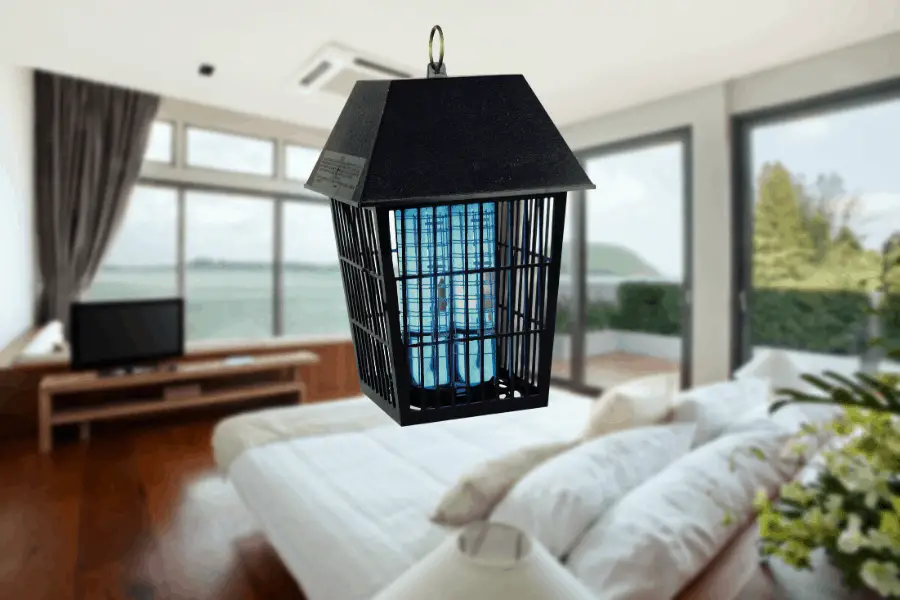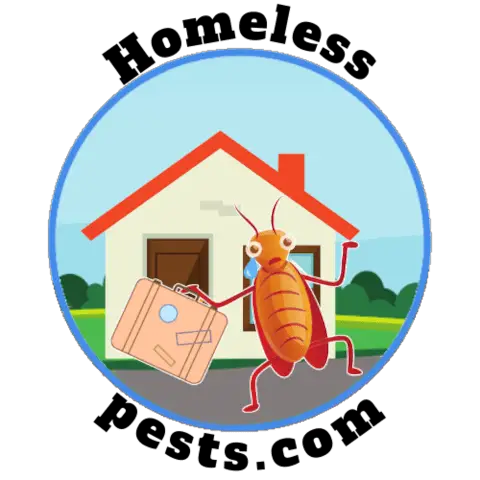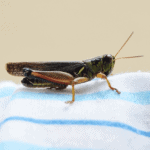
You ask yourself, “Can I use a bug zapper indoors?” It’s important to know the answer to this question before you decide. This article will explore whether or not it is safe to use a bug zapper inside your house, and if there are any other options for getting rid of bugs without using one.
Bug zapper use inside a home is safe if it is placed in child, water, and fire hazard-free location. Leaving a bug zapper unattended isn’t wise. Never place one next to soft furnishings, such as drapes. The vaporized remains of disease-carrying bugs in the air may lead to health issues if inhaled.
Overall, the answer to this question is that it depends, and for more information, I invite you to continue reading this article.
How does a bug zapper work?
Bug zappers work by attracting insects via a UV light source and then providing a lethal electric shock when the bug enters the internal part of the device. The remains are then collected in some sort of receptacle ready for emptying later. However, most biting pests aren’t attracted to them.
The charge in the electric grid is lethal for most insects, usually killing them on contact. The total number of bugs killed per night varies based on many factors such as insect populations and the zapper model. For example, a black light may attract mosquitoes but not kill them because they are drawn to it by warmth rather than ultraviolet light.
Can I use a bug zapper for the outdoors in my home?
There are several models of bug zapper which can be used both indoors and outdoors. They more often than not need to suspended, which increases their efficiency and can reduce the risk to the homeowner. Using a bug zapper not specifically labelled for indoor use is unwise.
The principles that most bug zappers work on are just as valid for interior use as the exterior. Since zappers kill bugs through a process of electrocution, they will work just as well in your kitchen as in your yard.
A bug zapper for indoor use is best hung up high as this makes it much safer for pets and small humans. This not only reduces risk of harm but also increases effectiveness by suspending it in the air where your target pests congregate.
It’s extremely important that you place the bug zapper in a safe place. Placing it too close to a normal, non-metal object can cause the zapper’s electric charge to travel from its metal grid and into your other object, causing a fire.
If, for example, your drapes were blown into the zapper by the wind, there is a chance that it could set them ablaze. So, make sure you always keep an eye on the bug zapper and never leave it one when you are out of the house or asleep. Safety first!
Where is the best place to put a bug zapper?
The ideal placement of a bug zapper, both indoors and outdoors, is where lots of insects reside & where it is conspicuous. Most zappers use UV light to attract bugs, so placing it in a dark location makes it more attractive. Also ensure no flammable material can fall onto the electric current.
You want to make your bug zapper the most attractive thing around, so minimizing the distractions nearby are key to lure insects in. If your bug zapper is indoors, place it in a less well-lit room. If you have more than one door into the room with the insect killer, be sure to put them at each entrance for maximum coverage and effectiveness.
Outside, it’s recommended that you put bug zappers ten to twenty feet away from the place you plan to entertain in and also at least 6 feet off the ground. This just makes things a little more pleasant for your guests.

Recommended bug zapper
Here is a shortlist of bug zappers that you can use in your home and backyard and will be effective against flies and mosquitoes. You can find these types of products in your local hardware store or follow the links provided to the Amazon store.
Dynatrap DT1050-AZSR

You can find this product on Amazon
DynaTrap DT2000XLP

You can find this product on Amazon
LiBa Bug Zapper (Indoor 2800V Grid)

You can find this product on Amazon
Mosquito Magnet MM4200B Patriot Plus

You can find this product on Amazon
Will bug zappers cause fires in your home?
Bug zappers are not inherently a fire risk but do carry the same threat as any other electrical device. They may have an added danger as their combustible elements are exposed and large insects have been known to catch fire as they are electrocuted. However, with diligent use, the risks are low.
Before installing a bug zapper, have a good look at the intended placement area. Are there any loose fittings or material that could blow into it? Is it going to be directly placed against any combustible material? Do you have adequate safety fuses installed?
Simply put, just be sensible when using them. Keep the devices out of reach of children and away from pets who could compromise its safety. Never leave the zapper unattended for long periods, especially if using it in your home.
With proper use, your bug zapper will be a safe and effective way to keep bugs out of your home.
Does a bug zapper work on mosquitoes?
For a bug zapper to be effective against mosquitoes it needs to use carbon dioxide or heat as a means of attracting them. These pests aren’t lured to UV lights like other insects. Models which have been designed for zapping mosquitoes do exist and they are very effective in reducing their numbers.
I’ve seen a lot of people saying that bug zappers never work on mosquitoes, and that simply isn’t true. Granted, some older or less well-designed models may only deal with flies, but there are a lot of choices for targeting mosquitoes.
It’s important to understand that mosquitoes are most attracted to, well, us. Humans. Short of hanging a bag of blood up, the next best thing is to simulate us exhaling CO2. There are bug zappers that do this job well.
You can also use these traps inside because the levels of CO2 used won’t be harmful to you and your family. Although, there are other methods you can use to deter and kill this pest in addition to using a bug zapper.
Do bug zappers work against cockroaches?
Bug zappers are not an effective method to combat a resident cockroach infestation. Roaches are simply not attracted to the UV light that most zapper models use to attract pests. In addition, cockroaches don’t always travel by flying around, so even accidental electrocution would be rare.
There are far better ways to deal with a cockroach problem than relying on a bug zapper. The best natural ways include using deterrents such as peppermint or baits that the cockroaches can’t resist.
Boric acid is a popular insecticide for cockroaches and has a much higher success rate than any bug zapper.
If you have an insect problem, it is best to get rid of the source of the infestation and not just focus on killing them with chemical or electrical methods. You’ll save time in the long run rather than having an endless battle against pests that are constantly breeding new generations.
Do bug zappers work in daylight?
Bug zappers certainly do work during the day but a lot less efficiently than at night. This is because the UV light intended to attract insects has a lot of natural competition. Placing the bug zapper in a shaded area will increase its effectiveness during the daytime.
You will hear your bug zapper popping away almost as much during the day as at night, but I can’t deny that it will kill fewer bugs. it’s simply because most designs rely on a visual stimulate to attract the bugs to a place where they can be electrocuted.
During the day, you can try to minimize the presence of insects such as flies by covering garbage cans or your food as this will attract them even more than the UV light in your bug zapper.
Are bug zappers good for the environment?
There is a strong argument that bug zapper are not eco-friendly as most of the insects they kill aren’t the target pests. Extensive use of these devices could lead to a depletion of a natural food supply. This is why it’s best to invest in a bug zapper that targets the type of pest you want to kill.
Unfortunately, these traps do not discriminate between friendly bugs and mean bugs. If an insect finds the trap attractive, it’s going to die whether we should be preserving it or not.
The idea of bug zappers is that the insects fly in to get close enough to be killed. They are attracted by UV light and set off a grid or lamp inside, where they’re hit with a strong electric charge from a charged metal mesh. This will kill anything from lovely butterflies to mean horseflies.
So, if you are at all concerned about the ethical use of bug zappers, explore other more environmentally-friendly ways to protect yourself against these pests.

What are the alternatives to a bug zapper?
If you want to use a bug zapper in your home but don’t want to take the risk of using a fixed unit, you can opt for an electrified racket. This doesn’t mean that you have to hunt down flies and mosquitos yourself, but it does remove any of the risks you may be concerned about.
Electric Fly Swatter

You can find this product on Amazon
I personally find this is a great little tool to get rid of the mosquitoes that are flying around me when I’m watching TV or in the home office.
Sources
https://lancaster.unl.edu/pest/roach/roach10Eng.pdf
https://hortnews.extension.iastate.edu/1996/6-14-1996/bugzapper.html
https://www.nytimes.com/wirecutter/blog/do-bug-zappers-work/






